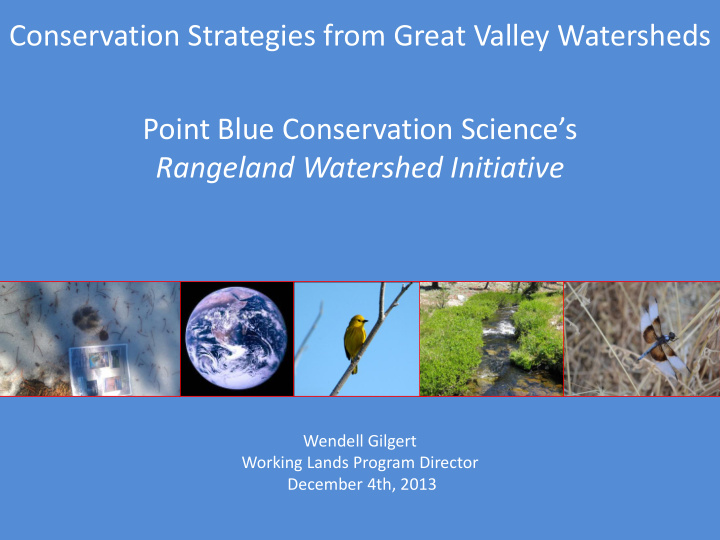



Conservation Strategies from Great Valley Watersheds Point Blue Conservation Science’s Rangeland Watershed Initiative Wendell Gilgert Working Lands Program Director December 4th, 2013
Advance conservation through bird and ecosystem studies, restoration and partnerships • Founded in 1965 • 140+ staff and seasonal biologists • 2013 Budget: ~$10m
Rangeland Watershed Initiative Goal: Improve watersheds by enhancing grazing lands and connecting them with riparian areas and valley wetlands, with a focus on the foothills surrounding the Central Valley.
Rangeland Watershed Initiative: Vision • Rangelands hold and store more water, release water more slowly throughout the year • Watersheds linked to valley floor riparian and wetland habitats • Increased groundwater recharge • Ranchers and farmers active partners in eco- friendly management • Ranching remains a viable enterprise • Improved landscape resilience to predicted extension of dry season conditions and climate change
Partner Biologists On the Ground Tiffany Russell Alicia Young Corey Shake Kelly Weintraub Melissa Odell
Upper Stony Creek Watershed Upper Stony Creek
Upper Stony Creek Model
Bringing Back Water
Same Creek, Re-watered, 8 years later
Pre and Post Prescriptive Grazing
Managing the Soil Surface
Watershed => Water Catchment
Conservation Management Practices Mgt & Restoration of Rare & Prescribed Grazing Management Declining Habitats Wetland Wildlife Management Upland Wildlife Habitat Management
Conservation Facilitating Practices Fence Fence Spring Development Water Facility
Conservation Accelerating Practices Brush Management Range Planting Fire Break Prescribed Burning
Case Study: Economics of Prescribed Grazing Upper Stony Creek Project Glenn County, California • Six years of prescribed grazing • Went from feeding 300 tons hay year to feeding NO hay • Increased herd from 300 cow/calf to 500 cow/calf • Improved flows of 1 st and 2 nd order streams (improved resources during this period)
Managing for Biodiversity
First Year: On the Ground 1)Expanded new practices on 370,000 acres with 60 landowners; 2)Managing to increase soil water storage on participating ranches by 15%; 3)Leveraged $12.5m Farm Bill habitat funds & $12.5m in landowner contributions; 4)Cultivating 30 Leopoldian land stewards for long-term ecological benefits; and, 5)Documenting, communicating habitat & water benefits of Point Blue RWI.
Research Support UC Davis Rangeland Watershed Lab Dr. Ken Tate Dr. Leslie Roach
Research Support Benchmark and Implementation Metrics
Field Metrics-Soils & Vegetation Soil Characteristics: Rangeland Vegetation: % cover of perennial species Line-intercept transects Soil bulk density Soil samples % cover of annual species (e.g., smooth brome, Line-intercept transects Soil organic matter Soil samples rye, fescue) Soil carbon Soil samples % cover of noxious/invasive weeds (e.g., Line-intercept transects Soil infiltration Soil samples medusahead, star thistle)
Hydrologic Characteristics Stream Flow: Presence / absence of base flow on 1 st and Visual survey, observation wells 2 nd order streams (# of days, dates) Change in flow volume on sample creeks Photo-points, stream gauges Stream macro-invertebrates (e.g., Line-intercept transects caddisflies, mayflies)
Biological Characteristics Birds and Wildlife: Number of species Point count surveys detected Number of species Area search breeding on site surveys Stream macro- Line-intercept invertebrates (e.g., transects caddisflies, mayflies)
Leopoldian Land Stewards • Workshops • Questionnaires • Field Techniques
Questions
Recommend
More recommend